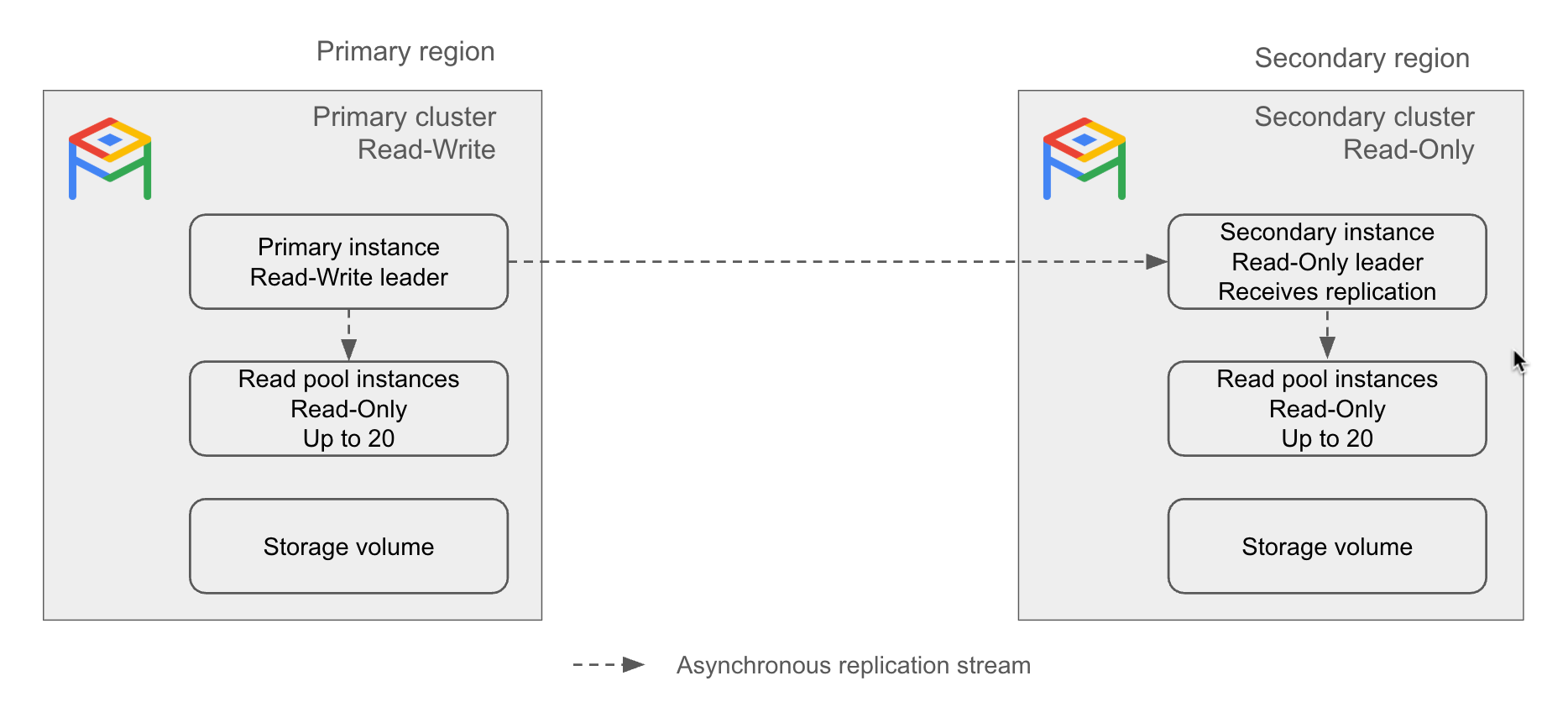Cette page présente la réplication interrégionale AlloyDB pour PostgreSQL.
La réplication interrégionale AlloyDB vous permet de créer des clusters et des instances secondaires à partir d'un cluster principal afin de rendre les ressources disponibles dans différentes régions en cas d'indisponibilité dans la région principale. Ces clusters et instances secondaires fonctionnent comme des copies de vos ressources de cluster et d'instance principales.
Voici les principaux concepts abordés sur cette page :
Cluster principal : Cluster en lecture/écriture dans une seule région.
Cluster secondaire. Cluster en lecture seule situé dans une région différente de celle du cluster principal et qui effectue une réplication à partir du cluster principal de manière asynchrone. En cas de défaillance d'un cluster principal AlloyDB, vous pouvez promouvoir un cluster secondaire en cluster principal.
Vous pouvez créer jusqu'à cinq clusters secondaires pour un cluster principal. Tous les clusters secondaires effectuent une réplication à partir d'un seul cluster principal. Si vous promouvez un cluster secondaire, il devient un cluster principal indépendant.
Instance secondaire. Leader en lecture seule d'un cluster secondaire. Il est chargé de recevoir un flux de réplication à partir d'un cluster principal. Le flux de réplication met à jour le volume de stockage dans la région secondaire en fonction du volume de stockage dans la région principale. Si un cluster secondaire est promu en cluster principal, l'instance secondaire devient l'instance principale.
Une instance secondaire peut être de base (zonale) ou à haute disponibilité (régionale).
Le schéma suivant illustre le fonctionnement de la réplication multirégionale :

Figure 1 : Exemple d'architecture de réplication AlloyDB multirégionale.
Avantages
Voici les avantages de la réplication interrégionale sur AlloyDB :
Reprise après sinistre : Si la région du cluster principal devient indisponible, vous pouvez promouvoir les ressources AlloyDB d'une autre région pour répondre aux requêtes.
Réduction des temps d'arrêt : La prise en charge de la haute disponibilité (HA) sur les clusters secondaires réduit les temps d'arrêt lors des événements de maintenance ou des pannes imprévues.
Données réparties géographiquement : La distribution géographique des données les rapproche de vous et réduit la latence en lecture.
Scaling de lecture amélioré : chaque réplica multirégion (ou cluster secondaire) peut prendre en charge jusqu'à 20 nœuds de lecture, ce qui vous permet de faire évoluer davantage vos lectures.
Basculement sans perte de données. Pour les configurations de réplication interrégionales, AlloyDB permet le basculement entre l'instance principale et l'instance secondaire sans perte de données.
Utiliser la réplication interrégionale
L'utilisation de la réplication AlloyDB interrégionale implique les tâches suivantes :
Créez un cluster secondaire. Un cluster secondaire est une copie de votre cluster principal AlloyDB qui est mise à jour en continu.
Affichez un cluster secondaire. Une fois que vous avez créé un cluster secondaire, vous pouvez afficher ses détails sur la page Clusters de la console Google Cloud .
Ajoutez des instances de pool de lecture. Vous pouvez ajouter des instances de pool de lecture à un cluster secondaire. Si vous souhaitez faire évoluer horizontalement votre capacité de lecture, vous pouvez ajouter jusqu'à 20 nœuds de lecture à votre cluster secondaire.
Promouvoir un cluster secondaire Vous pouvez lire les données d'un cluster secondaire, mais vous ne pouvez pas y écrire tant que vous ne l'avez pas promu en cluster principal autonome et complet. Lorsque vous promouvez un cluster secondaire, l'instance secondaire du cluster est également promue en tant qu'instance principale avec accès en lecture et écriture.
Le principal cas d'utilisation de la promotion d'un cluster secondaire est la reprise après sinistre. En cas d'indisponibilité régionale dans la région de votre cluster principal, vous pouvez promouvoir votre cluster secondaire en cluster principal autonome et reprendre la diffusion de votre application.
Basculement sans perte de données Le basculement vous permet d'inverser les rôles de votre cluster principal et de votre cluster secondaire sans aucune perte de données. Vous pouvez effectuer une permutation pour tester votre configuration de reprise après sinistre ou migrer votre charge de travail. Lorsque vous effectuez la commutation, le sens de la réplication est inversé.
Si vous avez plusieurs clusters secondaires, celui qui reçoit la commande de basculement devient un cluster principal. L'ancien cluster principal devient un cluster secondaire, qui réplique les données à partir du nouveau cluster principal. Tous les autres clusters secondaires passent à la réplication à partir du nouveau cluster principal.
Il existe deux scénarios courants pour basculer vers votre cluster secondaire :
- Exercices de reprise après sinistre : Vous pouvez tester vos processus de reprise après sinistre en basculant votre application vers une autre région sans perte de données pour simuler une indisponibilité régionale.
- Migration régionale : Effectuez une migration planifiée des ressources AlloyDB de leur région principale vers une autre région. Le basculement garantit que le cluster secondaire devient un cluster principal avec un objectif de point de récupération (RPO) de 0, ce qui permet de s'assurer qu'aucune donnée n'est perdue lors de la migration.
Configurez des sauvegardes automatiques et continues. Par défaut, AlloyDB copie automatiquement les configurations de sauvegarde automatique et continue du cluster principal vers un cluster secondaire nouvellement créé. Si vous souhaitez utiliser des configurations de sauvegarde différentes pour votre cluster secondaire, vous pouvez modifier la configuration de sauvegarde lorsque vous créez un cluster secondaire.
Si votre cluster principal utilise le chiffrement avec clé de chiffrement gérée par le client (CMEK) pour les sauvegardes, effectuez l'une des opérations suivantes lorsque vous créez un cluster secondaire :
- Fournissez les paramètres de chiffrement CMEK pour les sauvegardes du cluster secondaire.
- Désactivez les sauvegardes pour le cluster secondaire.
Pour en savoir plus sur le chiffrement de vos sauvegardes avec CMEK, consultez Utiliser CMEK.
Vous pouvez modifier les paramètres de sauvegarde automatisée et continue pour le cluster secondaire après sa création.

